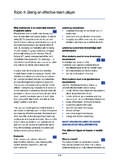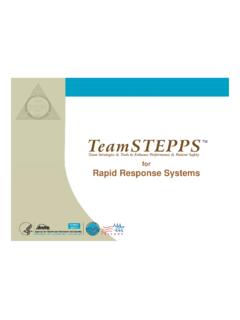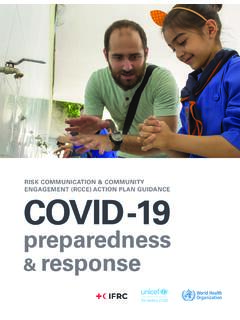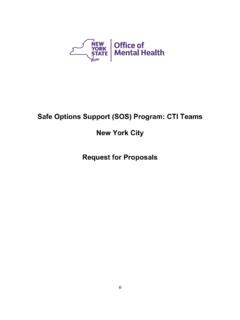Transcription of OPERATIONAL PLANNING GUIDELINES TO SUPPORT …
1 Draft as of 12 February 2020 COVID-19 Strategic Preparedness and response PlanOPERATIONAL PLANNING GUIDELINES TO SUPPORT COUNTRY PREPAREDNESS AND response World Health Organization 2020 Some rights reserved. This work is available under the Creative Commons Attribution-NonCommercialShareAlike IGO licence (CC BY-NC-SA IGO; )Under the terms of this licence, you may copy, redistribute and adapt the work for non-commercial purposes, provided the work is appropriately cited, as indicated below. In any use of this work, there should be no suggestion that WHO endorses any specific organization, products or services.
2 The use of the WHO logo is not permitted. If you adapt the work, then you must license your work under the same or equivalent Creative Commons licence. If you create a translation of this work, you should add the following disclaimer along with the suggested citation: This translation was not created by the World Health Organization (WHO). WHO is not responsible for the content or accuracy of this translation. The original English edition shall be the binding and authentic edition .Any mediation relating to disputes arising under the licence shall be conducted in accordance with the mediation rules of the World Intellectual Property designations employed and the presentation of the material in this publication do not imply the expression of any opinion whatsoever on the part of WHO concerning the legal status of any country, territory, city or area or of its authorities, or concerning the delimitation of its frontiers or boundaries.
3 Dotted and dashed lines on maps represent approximate border lines for which there may not yet be full agreement. The mention of specific companies or of certain manufacturers products does not imply that they are endorsed or recommended by WHO in preference to others of a similar nature that are not mentioned. Errors and omissions excepted, the names of proprietary products are distinguished by initial capital letters. All reasonable precautions have been taken by WHO to verify the information contained in this publication.
4 However, the published material is being distributed without warranty of any kind, either expressed or implied. The responsibility for the interpretation and use of the material lies with the reader. In no event shall WHO be liable for damages arising from its in Geneva, photo: OPERATIONAL PLANNING GUIDELINES TO SUPPORT COUNTRY PREPAREDNESS AND RESPONSEINTRODUCTION 02 COVID 19 preparedness and response PLANNING 02 Purpose of the PLANNING GUIDELINES 03 Next steps 03 PILLARS 04 Pillar 1.
5 Country level coordination, PLANNING , and monitoring 04 Pillar 2: Risk communication and community engagement 05 Pillar 3: Surveillance, rapid response teams, and case investigation 06 Pillar 4: Points of entry 07 Pillar 5: National laboratories 08 Pillar 6: Infection prevention and control 09 Pillar 7: Case management 10 Pillar 8: OPERATIONAL SUPPORT and logistics 11 ANNEXES 12 Annex 1: Key Performance Indicators 12 Annex 2.
6 Estimated resource requirement to prepare 14 for and respond to cluster of local transmission of up to 100 casesCONTENTS2 DRAFT OPERATIONAL PLANNING GUIDELINES TO SUPPORT COUNTRY PREPAREDNESS AND RESPONSEOn 30 January 2020, the Director-General of WHO declared the coronavirus disease 2019 (COVID-19) outbreak a public health emergency of international concern (PHEIC) under the International Health Regulations (IHR 2005), following advice from the IHR Emergency Committee. On 4 February 2020, the Director-General of WHO briefed the Secretary-General of the United Nations and requested the activation of the United Nations crisis management policy to establish a Crisis Management team (CMT) to coordinate the UN system-wide scale up to assist countries prepare for and respond to 6 February 2020 UN Development Coordination Office (UNDCO) hosted a call with WHO to brief all Resident Coordinators and UN Country Teams (UNCTs)
7 To provide updates on the COVID-19 epidemiological situation and introduce the COVID-19 Strategic Preparedness and response Plan (SPRP),1 emphasizing the importance of responding to the crisis as One UN. The primary objective of the international response to the COVID-19 outbreak remains stopping the human-to-human transmission of the virus, and caring for those affected. WHO is calling all partners to use this unique window of opportunity to act immediately to assist all countries to rapidly detect, diagnose, and prevent the further spread of the virus.
8 This guidance document outlines the measures to be taken at country level to contain the virus, and will be updated with further guidance if the epidemiological situation 19 preparedness and response planningThe SPRP outlines the public health measures that need to be taken to SUPPORT countries to prepare for and respond to COVID-19. It can be used to rapidly adapt National Action Plans for Health Security (NAPHS) and Pandemic Influenza Preparedness Plans (PIPP) to COVID-19, taking what we have learned so far about the virus and translating that knowledge into strategic action that can guide the efforts of all national and international partners to SUPPORT national on an initial assessment of country risk and vulnerability, the SPRP estimates the resource requirements to SUPPORT countries to prepare for and respond to COVID-19.
9 In many cases, national governments will be well placed to implement these measures with minimal SUPPORT . In other cases, partners may be best placed to implement measures where there is a gap in capacity, either on a national or subnational level, in SUPPORT of national governments. A detailed gap and needs analysis will need to be conducted in each affected country to develop a COVID 19 Country Preparedness and response Plan (CPRP) and resource requirements in SUPPORT of national governments. These CPRPs will need to be monitored using indicators based on those set out in the SPRP, and adapted as the situation should be noted that the costs outlined in the SPRP cover public health measures taken in SUPPORT of national preparedness and response and do not include the broader measures required to mitigate the social and economic consequences of COVID-19 or ensure business continuity of partner organizations.
10 Plans to ensure the continuity of essential services and mitigate social and economic impacts will need to be developed in parallel to the scaling up of the public health preparedness and response OPERATIONAL PLANNING GUIDELINES TO SUPPORT COUNTRY PREPAREDNESS AND RESPONSEP urpose of the PLANNING guidelinesThe purpose of this document is to provide a practical guide for the UNCTs and partners to develop a CPRP to immediately SUPPORT national governments to prepare for and respond to COVID-19. The initial CPRP should be developed for a 3-month period from 1 February to 30 April in alignment with the SPRP.

















